Trying a new theme.
What do you think?
Trying a new theme.
What do you think?
It was nice to speak with my brother Tom this morning on the phone. We chatted for about 45 minutes about our past.
He’s lived in Melbourne, Australia, for a very long time, so we don’t speak every week. However, we do try to catch up with each other, at least several times a year. His birthday is this month, and mine is in November.
Today, we were reminiscing about our childhood.
Just changed the Blog theme. This version is my favourite so far.
It’s called the Martha theme, with several additional plugins.
What do you think?
This is the Season of Creation
Accordingly, the Season of Creation is a celebration that allows all people to recognize ourselves as “the work of the Lord’s creative act,” to contemplate nature and all that dwells in it, and to care for our Common Home. It is necessary for all believers to join in the celebration of the Season of Creation. Since “what was good in the eyes of God has become an exploitable thing in the hands of man”, and it is urgent that as Church we implement concrete actions towards care and preservation.
I’m watching a CAFOD webinar on the 10th anniversary of Laudato Si. I urge anyone who cares for the earth to read the encyclical by Pope Francis.
Bad news.
Liverpool transfer moves have fallen through at the last moment.
So the defence problems remain unresolved.
Guehi is the signing that guarantees Liverpool the title, not Isak. As a Chelsea fan who thought he was the best academy product since JT, selling him for peanuts to Palace was bad enough, but to see Liverpool grab him when we have a huge central defensive hole is awful!
Liverpool agree to sign Guéhi for initial £35m
Liverpool have agreed a deal to sign Marc Guéhi from Crystal Palace for £35m plus £5m in add-ons. The defender has been given permission to undergo a medical in London before joining the champions.
Do you remember the old village notice board that used to stand proudly before the newer boards were attached to the Post Office? It was a charming wooden frame with a pinboard surface, but it was tricky. Many folks ended up using staple guns to get their notices to stick!

Over time, the board became quite the jumble. People would leave their notices well past their expiration dates, and it wasn’t uncommon for someone to post right over someone else’s announcement. With so many notices, especially advertisements and items for sale, we lost some of that sense of community the board was supposed to promote.
But good news! The Formby Parish Council stepped in to make a change. They removed the old notice board to freshen things up and reveal what lay behind it.
Thanks to the efforts of the newly restored Parish Council, we now have two wonderful boards: one serves the formal needs of the Council, while the other is dedicated to our community. How great is that? Village notice boards truly play an essential role in our local life. They are central spots for sharing news, announcements, and events, helping to strengthen our connections and sense of belonging.
A Little Dive into the History of Public Notices
Ancient Rome (59 BC - AD 222) The first public notices were called Acta Diurna (Daily Acts) or Acta Populi, where official news was shared. Medieval Europe You could find stone notice boards in public squares, displaying important announcements from local leaders and the church.
Britain (Medieval to Modern)
12th Century: Churches began putting up wooden boards for notices about services and events, often decorated with lovely religious art.
17th and 18th Centuries: Wooden and metal notice boards started to pop up more frequently in busy public areas, posting everything from news to advertisements.
19th Century: With the rise of railways and telegraphs, notice boards became common at train stations and telegraph offices.
20th Century: The arrival of cork and paper boards made it easier for people to post notices. By the mid-20th century, these boards were everywhere—in parks, workplaces, and schools!
Modern Day: Even with the growth of digital notice boards, our traditional wooden boards remain beloved and vital in community centres, local libraries, and other public places. They’re still an excellent way to connect and share what’s happening in our lives!
Follow @Formby on Micro.blog.
It’s all over 92-3.
Half-time 47-0. Despite some defiant defence by Samoa, they have been overwhelmed by an English side determined to dominate.
After 15 minutes, England are 26 points ahead.
Try, which is converted, England are ahead 7 - 0
The England v Samoa rugby match broadcast has just started on BBC Two, and is about to start.
I finally understand how to post, use CSS styling to structure stories, and design a post’s appearance.
I particularly like the similarities between Twitter and the X platforms. The emphasis on short, snappy posts is attractive and best suits my approach to composing a story.
I have used Twitter to “live-tweet” events and meetings.
I will still post longer stories, but the attraction in the immediacy of serial episodes in a developing story over a day is fun.
Good morning, one and all.
After the shocking news that my blog platform is closing soon, I will adapt with a sense of adventure to today’s new blog environment.
Yesterday, I was informed out of the blue that my blog site providers were closing their whole platform.
Here’s a comment from the originator of my new replacement blog site.
Typepad is shutting down after an amazing 20+ years. It was spun off of Movable Type in the very early days of the blogosphere. Seth Godin used to use it, too, and I see that his old URLs redirect, which is great.

Hello world, this is a short introductory post from my newest venture.